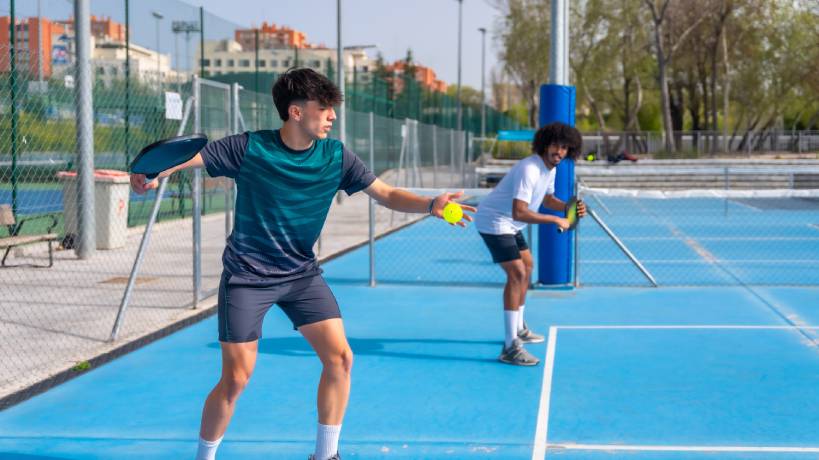Pickleball is a rapidly growing sport, and understanding how to keep score is crucial to fully enjoy the game. In this complete guide to keeping score in pickleball, you will learn all the essential aspects of scoring so you can focus on your technique and strategy.
Understanding the Basics of Pickleball Scoring

Players traditionally play pickleball in a doubles format, although singles games are common. The first thing to note is that pickleball uses rally scoring, which means only the serving team can score points.
The first team to reach 11 points wins the game, and a team must win by two points. Play continues until one team gains a two-point lead if the game reaches 10-10, often called a “win by two” scenario.
Each doubles team gets two serves (one per player), and teams can only score points when they’re serving and win the rally. The scoring system remains the same for singles matches but with only one server per side.
The Serving Sequence
In pickleball doubles, the serve rotates between teams and players. The server stands behind the baseline and hits the ball diagonally across the net to the opposite service court when serving.
The server continues to serve until they lose a rally, at which point their partner takes over serving. Once both players on a team have served and lost their serve, the serve switches to the opposing team.
The server calls out three numbers when announcing the score: their team’s score, the opposing team’s score, and whether they’re the first or second server. For example, “3-2-1” means the server’s team has 3 points, the opposing team has 2 points, and the server is the first server for their team.
Scoring in Doubles Play
The scoring sequence might initially seem confusing in doubles, but it becomes second nature with practice. The player on the right side of the court serves first when a team begins serving. They switch sides with their partner and continue serving if they win the rally.
The serve passes to their partner (now on the right side) if they lose the rally, and they begin serving. This process continues until both players on the team have lost their serves. The serve then transfers to the opposing team.
For example, the serving team has 5 points, the receiving team has 3, and it’s the second server’s turn if the score is 5-3-2. This scoring sequence helps everyone know who is serving and what the score is at any given moment, as only the serving team can score.
Side-Out: What It Means
A “side-out” occurs when the serving team loses the rally while their second server serves. The other team gains the opportunity to serve at this point.
During a side-out, the receiving team becomes the serving team, and the service rotation starts over. This feature of pickleball keeps the game balanced and competitive, as teams frequently switch between serving and receiving roles.
Side-outs are crucial because they mark the transition of power from one team to another. Since only the serving team can score points, earning a side-out is often a turning point in the game.
Pickleball Scoring in Singles Matches
The scoring system is simpler in singles matches because there’s only one player on each side. The server still announces the score before each serve, but they’ll only call two numbers: the server’s score followed by the opponent’s score. There’s no need to announce a first or second server, as there’s only one server per side.
Despite the differences, the objective remains the same: players must win by at least two points, and the game goes to 11 points. The rules for serving remain consistent with doubles, as the server must serve diagonally and alternate sides after each successful rally.
Winning the Game: Points and Strategies

A team or player must reach 11 points and be ahead by at least two points to win a game of pickleball. Some variations of pickleball extend the game to 15 or 21 points, especially in tournament play, but the win-by-two rule remains intact.
Scoring strategies can significantly impact the game. For example, experienced players often focus on earning side-outs and carefully controlling their serves to maintain a lead. A well-placed serve can put the opposing team in a difficult position, making scoring points easier.
Common Scoring Mistakes To Avoid
Pickleball’s scoring system can prove tricky for beginners, leading to common mistakes during games. One of the most frequent errors is forgetting to announce the score before serving. This mistake can cause confusion, particularly in doubles matches, where the first or second server status is crucial.
Another common mistake is failing to alternate sides after a successful rally. In doubles, players must switch sides with their partner after each rally won while serving. Failure to do so can result in a fault and the loss of the serve. Staying mindful of these rules maintains the game’s flow and helps all players understand the scoring and game situation.
How To Handle Tiebreakers
Most pickleball matches have a “best two out of three” format, with each team switching sides at the end of each game. The third game will typically decide the match if both teams have one game each.
However, teams can play a tiebreaker instead of a third game. Tiebreakers add excitement and tension to the game, as both teams must fight hard to pull ahead.
A team or player must score seven points and lead by two points to win a tiebreaker. The tiebreaker continues until someone has a two-point lead.
Players should remain calm and focused during tiebreaker situations. Patience, well-placed shots, and a strong mental game often make the difference in securing a victory during these high-pressure moments.
Keeping Track of the Score: Tips for New Players
Keeping track of the score while concentrating on gameplay can prove challenging for new players. However, some helpful tips can simplify the process.
One effective strategy is to repeat the score in your head before serving and after each point concludes. This practice reinforces the correct score in your mind and minimizes the chances of forgetting or confusing it.
It’s also helpful to announce the score loudly, and clearly, so all players are on the same page. Referees will typically keep track of the score for the players in tournament play, but it’s up to the players to stay mindful of the score count in casual games.
The guidelines outlined in this complete guide to keeping score in pickleball will remove any confusion during practice or matches. Make sure you have all the necessary pickleball court supplies to enhance your experience and keep your matches running smoothly when setting up a pickleball court or preparing for a game. Visit All Star Tennis Courts for the perfect equipment for this fun and competitive sport.

